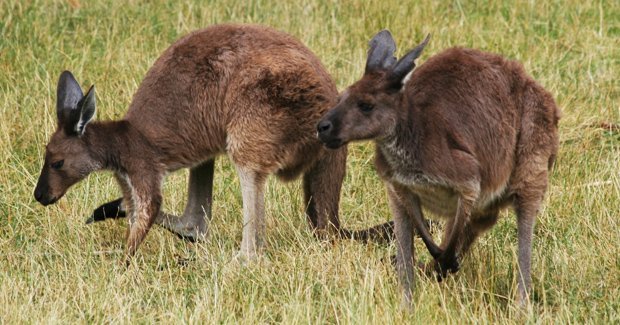Muscly arms helps roos attract the ladies

IT APPEARS HUMAN males are not the only ones that stack on the muscle to draw in the ladies.
A new study suggests that the size of arm and shoulder muscles in male kangaroos are not only used for fighting, but they could also be key to attracting the opposite sex.
Dominant male roos will even go one step further and display their forelimb muscles to attract females, the study suggests.
Bulky kangaroos more attractive
Lead researcher Natalie Warburton, along with a team from Murdoch University in Perth, studied populations of western grey kangaroo (Macropus fuliginosus) around Perth and Dunsborough in Western Australia.
The forelimbs of the male kangaroos were found to be disproportionately large for the size of animal, when compared to the muscles of the female. Natalie says the developed forelimb muscles “could be linked to the fact that male kangaroos establish and maintain their dominance hierarchy through sparring contests that involve grasping their opponent and using their back legs to box them.”
The paper, published this week in the Biological Journal of the Linnean Society, suggests that these key muscles provide a distinguishing feature for females choosing a potential mate.
Co-author Trish Fleming says the study is unique because it reveals which muscles kangaroos are may use to gain a select advantage over other males, resulting in a higher mating success rate.
Natalie says dominant males frequently strike poses to display their size and muscularity to females and other males. According to the study, which also involved researchers from Curtin University, this behaviour supports the theory that muscles increase a male’s attractiveness.
Roos display muscles for females
Dr Adam Munn, a biologist at the University of Wollongong, says male displays of physicality are also useful for other males to determine whether or not it’s worth engaging in a fight, and how high the chances of injury might be.
“That’s how males will size each other up, and decide who is the most dominant,” says Adam. “[It’s] very common across males in a lot of mammal species, you only need to go down to a local bodybuilding gym and you’ll see similar behaviours.”
Although muscular forearms may increase mating success, researchers suspect the extra bulk may come at a high price for the male kangaroo.
“Under conditions of extreme environmental stress, there is evidence that male mortality is greater, suggesting that maintaining this additional musculature incurs a significant cost,” says Natalie.
Adam agrees. “When kangaroos…go through drought, the two most vulnerable classes are juveniles and the very large, old males.”
Adam adds that the intense metabolic activity involved in maintaining such a muscular build can be damaging, and may have an effect on the animal’s lifespan.
RELATED STORIES

